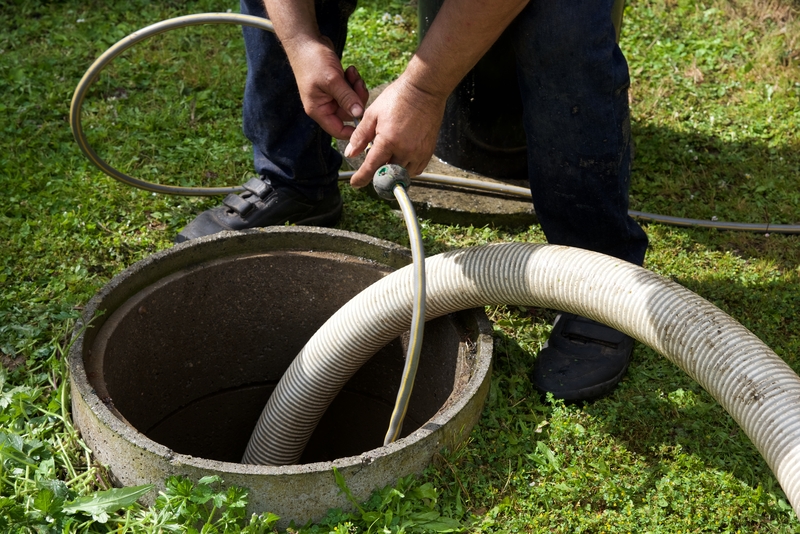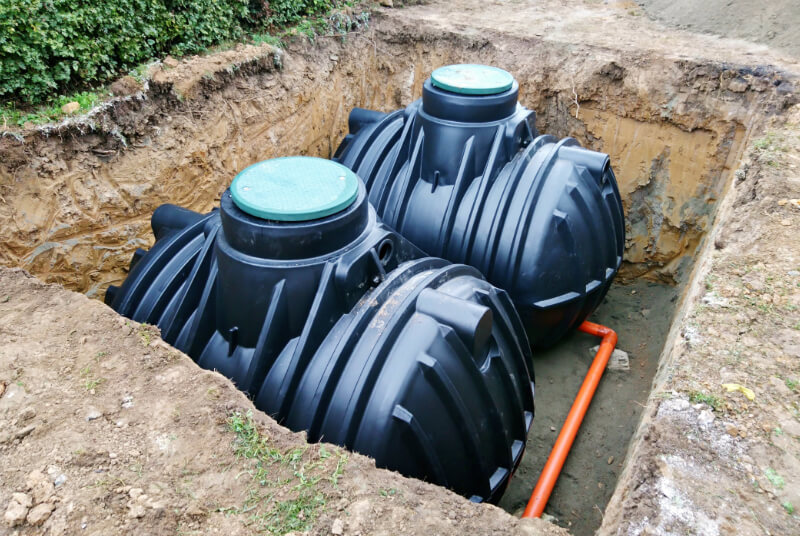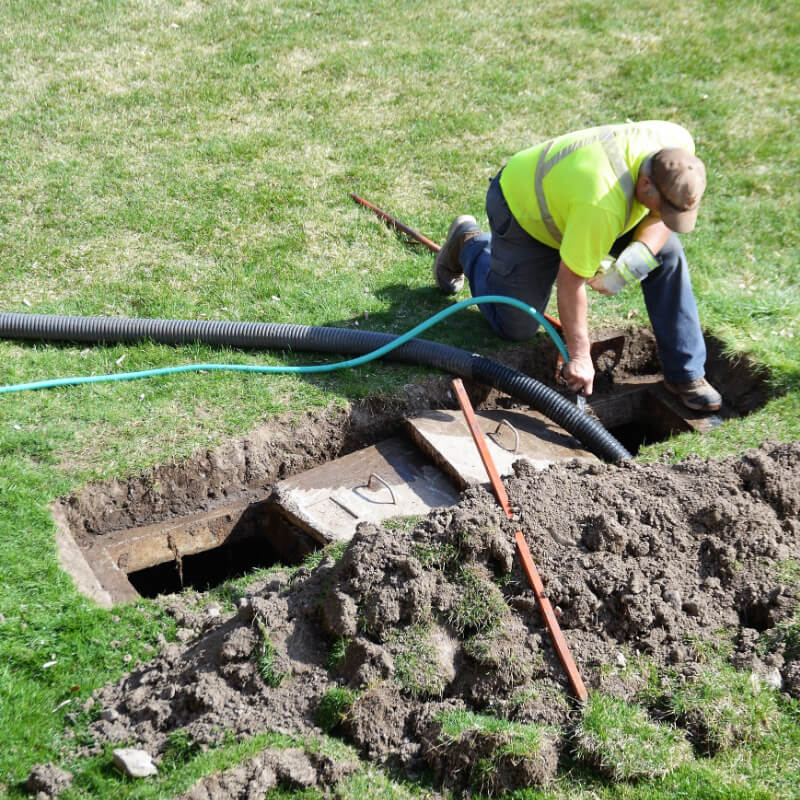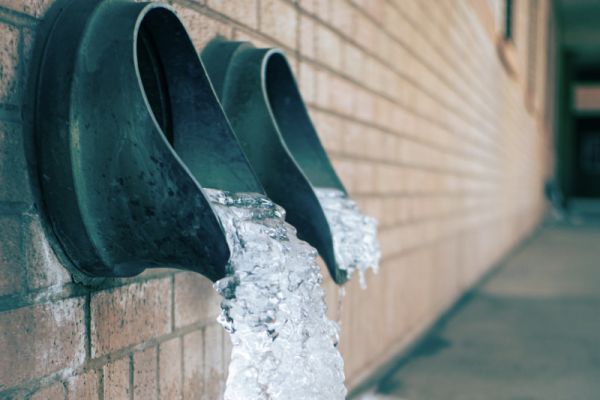In this article
How Fast Does a Septic Tank Fill Up?
If you've clicked this article, you're likely dealing with a full septic tank, and you're unsure what your next steps should be - well, don't worry, we've got you covered! As you'll know, septic tanks are crucial in managing wastewater effectively, especially in areas without access to municipal sewer systems. Understanding the rate at which a septic tank fills up is essential to ensure proper maintenance and prevent potential issues.
In this blog, we will explore the factors that influence the filling rate of septic tanks and explain why it is so important to empty and clean your septic tank.

Septic Tanks and their Functions
A septic tank is an underground, primary component of on-site sewage treatment plant systems commonly used in areas without centralised sewer systems. Let's take a look at the main functions of these septic tank systems so that we can better understand when and why they fill up.
- Wastewater Treatment: The primary function of a septic tank is to treat wastewater from toilets, sinks, showers, and laundry facilities.
- Solid Waste Decomposition: Inside the septic tank, anaerobic bacteria break down organic solids in the sewage, converting them into gases, liquids, and more easily manageable sludge. This decomposition process helps reduce the volume of solid waste over time.
- Separation of Layers: As wastewater enters the septic tank, it undergoes a natural stratification process. Heavier solids settle at the bottom to form sludge, while lighter particles, fats, and oils float to the top to create scum.
- Effluent Disposal: Once the solid waste is digested and separated, the liquid effluent exits the septic tank and flows into the drain or leach fields for further treatment and absorption into the soil. Proper disposal of effluent is crucial to prevent groundwater contamination.
- Maintenance Requirements: Regular maintenance, including periodic pumping of the tank to remove accumulated sludge and scum, is essential to ensure the septic system functions efficiently. Failure to maintain the tank can lead to clogging, backups, and environmental hazards.
Understanding Septic Tank Capacity in the UK
Understanding the capacity of septic tanks is essential for maintaining proper functionality and preventing potential issues for you and your home. Let's take a look at septic tank sizes and how this affects the functionality of these domestic sewage treatment plants.
Size Range of Septic Tanks
Septic tanks in the UK come in various sizes tailored to household requirements. However, Residential septic tanks typically range from 2,700 to 4,500 litres for smaller households. Larger families or properties with higher water usage may opt for tanks ranging from 9,100 to 18,000 litres.
Factors Influencing Filling Rate:
Many factors can impact how quickly a septic tank fills up. Let's examine the main ones.
- Household Size: The number of occupants in a household directly influences wastewater production and the speed at which the tank fills.
- Water Usage: British water usage habits, such as frequent baths, laundry, and dishwashing, can contribute to a faster fill-up rate.
- Tank Maintenance: Regular maintenance practices, including scheduled pump-outs and inspections, are vital for optimal tank performance and longevity.
So, what is the average timeframe for reaching capacity?
For an average UK household of 3-4 people with moderate water consumption and regular maintenance, a septic tank may reach capacity in approximately 3 to 5 years. However, households with larger families, higher water demands, or inadequate maintenance routines may experience quicker filling rates, necessitating more frequent servicing every 1-3 years.
Signs of a Full Septic Tank
When a septic tank is approaching total capacity, a few signs will indicate this.
- Slow Draining Fixtures: Sinks, toilets, and showers may drain more slowly than usual, indicating a potential backup in the system.
- Unpleasant Odors: Foul odours emitting from drains or around the property can signal a full or malfunctioning septic tank.
- Pooling Water: Standing water or lush vegetation near the drain field may suggest that the septic tank is overflowing.
Potential Consequences of an Overfilled Septic Tank
An overfilled septic tank can lead to various issues for you, your family, and your home. Making sure your septic tank's health is in good condition is one of the most important things you should prioritise in your home.
What happens if you don't empty your septic tank?
- Backups into the Home: Sewage backups can occur in toilets, sinks, or showers, posing health hazards and requiring costly cleanup.
- Damage to Drain Field: Excess wastewater can saturate and damage the drain field, leading to system failure and expensive repairs.
- Contamination: Leaking sewage from an overfilled tank can contaminate groundwater, posing environmental and health risks.
Best Practices for Preventing Premature Filling
Several things can be implemented in your lifestyle and home to avoid premature septic tank filling. Let's look at the main considerations so you can benefit from well-maintained septic tanks.
- Limit Water Usage: Be conscious of water consumption by fixing leaks, using water-efficient fixtures, and spacing out laundry and dishwasher loads.
- Proper Waste Disposal: To prevent clogs and tank buildup, avoid flushing non-biodegradable items, chemicals, grease, or excessive solid waste down the drains.
- Regular Pump-Outs: Schedule routine pump-outs every 3-5 years, or as professionals recommend, to remove accumulated solids and maintain tank capacity.
- Use Septic-Safe Products: Choose cleaning and personal care products labelled as septic-safe to minimise the impact on bacterial balance within the tank.
- Protect Drain Field: Avoid parking vehicles or planting trees near the drain field to prevent damage to the system's absorption area.
- Monitor Vegetation: Regularly inspect the drain field for excessive plant growth, which can indicate issues with wastewater absorption.
Maintenance Schedules and Inspections:
To prevent these consequences and maintain a healthy septic system, homeowners can schedule Regular Inspections and arrange for professional inspections to assess the tank's fullness and detect any potential issues early.
Maintaining optimal septic tank function requires regular upkeep and professional assessments:
- Annual Inspections: Arrange for yearly inspections by certified professionals to evaluate the tank's condition, assess sludge levels, and identify potential problems.
- Routine Maintenance: Follow a maintenance schedule that includes pump-outs, filter cleanings, and overall system checks to ensure smooth operation and longevity.
- Keep Records: Keep detailed records of maintenance activities, inspections, and any issues encountered to track the tank's history and inform future servicing needs.
By adhering to these preventative measures, adopting practices to extend the tank's lifespan, and incorporating regular maintenance and inspections into their routine, homeowners can proactively care for their septic systems and mitigate the risk of premature filling or system failure.
Emptying or Servicing a Full Septic Tank:
When it comes to emptying or servicing a full septic tank, it is essential to follow proper procedures to maintain the system's functionality and prevent potential issues. Here are the steps involved in emptying or servicing a full septic tank:
- Assessment: Begin by assessing the septic tank's current condition, including its solids and liquids level. Signs of a full tank may include slow drainage, odours, or sewage backups.
- Hiring a Professional: It is recommended that a licensed septic tank service provider be hired to handle the emptying or servicing process. Professionals have the expertise and equipment to safely and effectively pump out the tank's contents.
- Pumping Out: The service provider will use a vacuum truck or pump to extract the accumulated sludge (solid waste) and scum (floating debris) from the septic tank. This process should be done thoroughly to prevent blockages and maintain the tank's efficiency.
- Inspection: After pumping out the tank, the service provider may inspect to check for any signs of damage or leaks within the tank. Identifying problems early can prevent costly repairs in the future.
Septic Tank Tips
Avoid Contamination:
Adhere to safe disposal practices and guidelines to prevent contamination of soil and water sources. Responsible waste management safeguards the quality of soil and water, ecosystems, and public health. Protect Drainage Systems:
Responsible management of septic waste disposal plays a vital role in safeguarding the integrity of drainage systems and the surrounding environment. Homeowners prioritising proper disposal practices contribute to preserving their property's drainage infrastructure, preventing contamination and minimising the risk of system failures.
By ensuring that septic waste is handled responsibly and by regulations, you can protect your property and support the overall health and sustainability of the local environment.
Important to note
By addressing full septic tanks quickly and through professional servicing, you can safeguard your septic systems, preserve water quality, and maintain a healthy living environment for you and your family.
Final Thoughts
Understanding septic tank filling rates and implementing proper maintenance practices are essential for ensuring the longevity and efficiency of your septic systems. By recognising factors that influence filling rates, such as household size, water usage, and maintenance habits, you can proactively manage your systems to prevent premature filling and potential issues.
Regular inspections, pump-outs, and responsible waste disposal play crucial roles in extending the lifespan of septic tanks and maintaining optimal operation. If you have any other questions regarding your septic tank, please contact us today. Our team of experts is here to answer any of your queries about sewage tanks, drainage field problems, or drainage pipe and blockages.
Get in touch
Contact our friendly and professional team via form, phone or email for any drainage issues you may have.
From blocked drains to septic tank repairs and replacements, we're here to help. We have over 25 years of experience and offer 24/7 emergency callouts.
-
01386 882324
-
WhatsApp
-
This email address is being protected from spambots. You need JavaScript enabled to view it. -
See what our customers think





